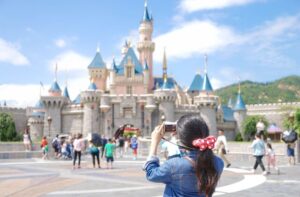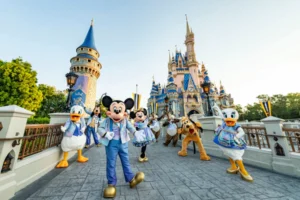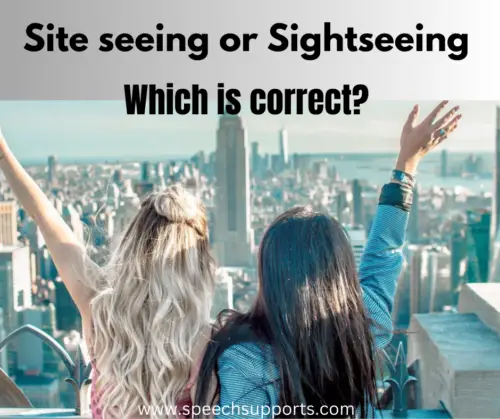When planning a journey or embarking on a vacation, one often encounters the terms “site seeing or sightseeing. At first glance, these phrases might seem nearly identical, with only a single space setting them apart. However, this subtle distinction can significantly affect your travel experience.
In this exploration, we delve into the world of Site Seeing vs Sightseeing to unravel their true meanings, highlighting how the choice between these two expressions can shape the way we perceive and enjoy the places we visit.
Whether you’re a seasoned traveler or a curious explorer, understanding the nuances between these terms will enhance your adventures and allow you to make the most of your journey. Let’s embark on this enlightening journey to uncover the hidden intricacies of site seeing and sightseeing.
Understanding site seeing or sightseeing

Site seeing” and “sightseeing” are similar terms, but they have different meanings and are used in slightly different contexts.
-
Sightseeing:
-
- Definition: Sightseeing refers to the activity of visiting interesting or famous places, attractions, landmarks, or natural wonders in a particular location. It is usually done for leisure, cultural enrichment, or educational purposes.
- Example: When tourists visit a city, they often engage in sightseeing by visiting popular places like museums, historical sites, parks, and other noteworthy locations.
-
Site Seeing:
-
- Definition: “Site seeing” is not a standard English term. It might be a typographical error or a misuse of the term “sightseeing.” If someone uses this term, they likely mean “sightseeing.”
- Possible Confusion: Sometimes, people might mistakenly write “site seeing” when they actually mean “sightseeing” due to the similarity in pronunciation.
It’s important to note that “sightseeing” is the correct term used to describe the activity of visiting places of interest. If you encounter the term “site seeing” in writing, it’s likely a mistake, and you should use “sightseeing” instead.
Common example of how to use site seeing or sightseeing
Sightseeing” and “site seeing” are closely related terms, but they have slightly different meanings and usages:
Sightseeing:
- When I visited New York City, I went sightseeing in Central Park and Times Square.
- Sightseeing in Rome is a fantastic way to explore its rich history and architecture.
- They offer guided sightseeing tours of the city’s historic district.
- During our vacation in Hawaii, we enjoyed sightseeing along the beautiful coastline.
- The tour bus took us sightseeing through the charming countryside of Tuscany.
- My favorite part of sightseeing is visiting museums and art galleries.
- If you’re in San Francisco, don’t miss sightseeing at Alcatraz Island.
- We spent the morning sightseeing and the afternoon shopping in the local markets.
- Sightseeing in Kyoto allowed us to experience traditional Japanese culture.
- People from all over the world come to Paris for sightseeing and romantic walks along the Seine River.
Site Seeing:
- The construction crew spent the day site-seeing to assess the progress on the building project.
- The engineers went site-seeing to ensure that the construction was proceeding according to the plans.
- Site-seeing at the archaeological dig revealed ancient artifacts buried beneath the earth.
- The environmentalists went site-seeing in the forest to study the local wildlife.
- The safety inspectors conducted site-seeing to check for any potential hazards.
- The manager went site-seeing at the factory to evaluate production efficiency.
- The supervisor regularly conducts site-seeing to ensure employees are following safety protocols.
- Site-seeing is an essential part of the job for urban planners, who evaluate potential locations for development.
- The scientists spent the week site-seeing at the research station in Antarctica.
- The real estate agent scheduled a site-seeing tour for prospective buyers interested in the property.
Common misconceptions and confusion between site seeing or sightseeing

The confusion between “site seeing” and “sightseeing” typically arises from spelling or typographical errors and the similarities in pronunciation. As previously mentioned, “site seeing” is not a standard term in English, and the correct phrase is “sightseeing.”
Here are some common misconceptions and sources of confusion related to these terms:
- Spelling Errors: People may inadvertently write “site seeing” instead of “sightseeing” because the words “site” and “sight” are homophones (they sound the same) and have a similar appearance in writing.
- Misinterpretation: Readers might misinterpret “site seeing” as a valid term and assume it means the same as “sightseeing.” This can lead to misunderstandings.
- Auto-Correct or Predictive Text: Autocorrect features on smartphones and other devices may automatically change “sightseeing” to “site seeing” if they are not recognized as valid words, further contributing to the confusion.
- Language Barriers: Non-native English speakers might not be familiar with the term “sightseeing” and may use “site seeing” instead, thinking it is the correct expression.
To avoid these misconceptions and confusion, it’s important to use the correct term, “sightseeing,” when referring to the activity of visiting places of interest. Furthermore, when reading texts or messages, context can often help you identify whether the writer intended to use “sightseeing” or if there was a typographical error.
Differences Between Site Seeing and Sightseeing
Site seeing” and “sightseeing” are similar-sounding terms, but they have different meanings and usage:
- Sightseeing:
-
- “Sightseeing” is a common term referring to the activity of visiting and exploring places of interest, tourist attractions, landmarks, and notable locations in a particular area. These places could include historical sites, natural wonders, museums, architectural landmarks, and cultural sites.
- Sightseeing typically involves the act of looking at or observing these points of interest, often to appreciate their beauty, historical significance, or cultural importance. It is a leisure activity for tourists and travelers who want to learn about and experience a new place or culture.
- Site seeing:
-
- “Site seeing” is a less common term and is not widely recognized or used. It might be considered a typographical error or a misspelling of “sightseeing.”
- In the context of “site seeing,” the meaning would depend on the specific context in which it is used, but it is not a recognized term in the same way that “sightseeing” is.
Common Mistakes and Misconceptions with Site Seeing or Sightseeing

Common mistakes and misconceptions associated with “site seeing” or “sightseeing” include:
- Spelling Errors: The most common mistake is misspelling “sightseeing” as “site seeing.” The incorrect term “site seeing” is often used due to confusion or typographical errors.
- Pronunciation Confusion: Some people may mispronounce “sightseeing” as “site seeing,” further compounding the confusion.
- Meaning of “Site Seeing”: As mentioned earlier, “site seeing” is not a recognized term and doesn’t have a clear definition. Some may incorrectly assume it refers to the act of physically seeing or observing a particular location or site.
- Underestimating Cultural Importance: A misconception is that sightseeing is solely about taking photographs and looking at landmarks, without appreciating their cultural, historical, or educational value. In reality, sightseeing often involves learning about the significance of the places visited.
- Equating Sightseeing with Tourism: While sightseeing is a common activity for tourists, it’s not limited to travelers. Locals can also engage in sightseeing to explore their own cities or regions and appreciate their cultural heritage.
- Rushing Through Sightseeing: Some people rush through sightseeing, trying to check off as many tourist attractions as possible without taking the time to fully appreciate the places they visit. Quality over quantity is often a more rewarding approach to sightseeing.
- Disregarding Environmental Impact: Tourists and travelers may sometimes disregard the environmental impact of their sightseeing activities, such as contributing to overcrowding in sensitive natural areas or not respecting local regulations.
- Assuming All Sightseeing is Expensive: Sightseeing doesn’t have to be expensive. While some popular tourist destinations and guided tours can be costly, there are many free or budget-friendly sightseeing opportunities available, especially in urban areas.
- Believing Sightseeing Is Only for Tourists: Some residents of a city or region may believe that sightseeing is only for tourists and overlook the beauty and cultural significance of their own surroundings.
- Overlooking Local Guides: Local tour guides can provide valuable insights and context during sightseeing. Some travelers may choose to explore on their own without realizing the benefits of local expertise.
To make the most of sightseeing, it’s important to understand its meaning, appreciate the cultural and historical aspects of the places you visit, and consider the environmental and social impact of your activities. Additionally, spelling “sightseeing” correctly can help avoid misunderstandings.
Tips for Proper Usage of Site Seeing or Sightseeing
To ensure proper usage of “sightseeing” and avoid the incorrect term “site seeing,” here are some tips:
- Spelling: Always use the correct term “sightseeing.” Double-check your spelling to avoid the common mistake of using “site seeing.”
- Pronunciation: Ensure you pronounce “sightseeing” correctly (sight-see-ing), rather than pronouncing it as “site seeing” (site-see-ing).
- Definitions: Understand the meaning of “sightseeing.” It refers to the activity of visiting and exploring places of interest, tourist attractions, landmarks, and notable locations. It involves looking at or observing these points of interest, often to appreciate their beauty, historical significance, or cultural importance.
- Context: Use “sightseeing” when discussing or describing the act of touring and exploring tourist attractions and landmarks. Avoid using “site seeing,” as it is not a recognized term.
- Avoid Confusion: If you encounter the term “site seeing” in your writing or conversation, recognize it as a likely error or typo, and correct it to “sightseeing.”
- Learn about the Places You Visit: When engaging in sightseeing, take the time to learn about the history, cultural significance, and context of the sites and landmarks you visit. This will enhance your experience and understanding of these locations.
- Respect Local Regulations and Environments: Be mindful of local regulations and environmental considerations when sightseeing, especially in natural areas and heritage sites. Follow guidelines to minimize your impact and preserve the places you visit.
- Quality Over Quantity: Instead of rushing through multiple tourist attractions, consider focusing on a few and spending more time at each to fully appreciate their value and significance.
- Engage with Local Guides: Consider hiring local guides or joining guided tours to gain insights and stories about the places you visit. Local guides can enhance your sightseeing experience.
- Share Your Experience: If you write about your sightseeing experiences or share them with others, use the correct term “sightseeing” in your descriptions and narratives.
By following these tips, you can ensure the proper usage of “sightseeing” and avoid the common mistakes associated with “site seeing.” This will help you communicate effectively and appreciate your travel experiences to the fullest.
Conclusion
The distinction between Site Seeing or Sightseeing lies in the use of these terms. “Site Seeing,” typically written as two separate words, pertains to the observation and evaluation of a specific location or site, often in professional or technical contexts.
On the other hand, “Sightseeing,” written as one word, refers to the enjoyable activity of exploring and visiting various tourist attractions, landmarks, and cultural sites in a particular area. So, whether you’re engaged in site seeing or sightseeing, the experience can be equally rewarding, each in its unique way.

